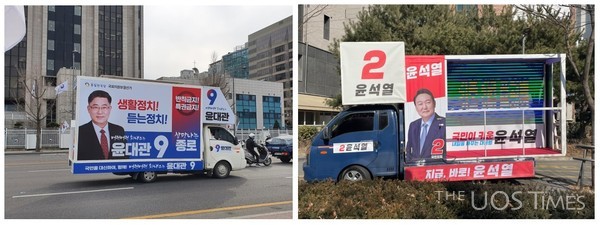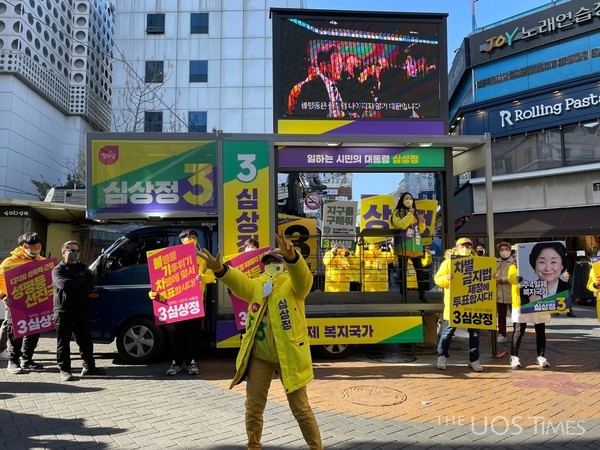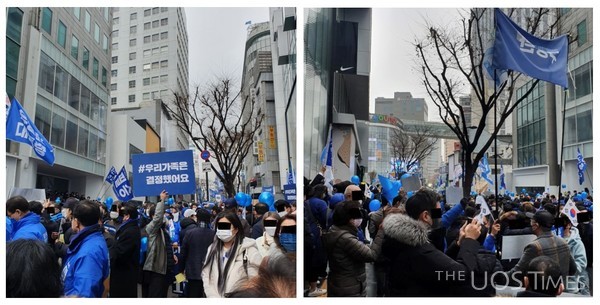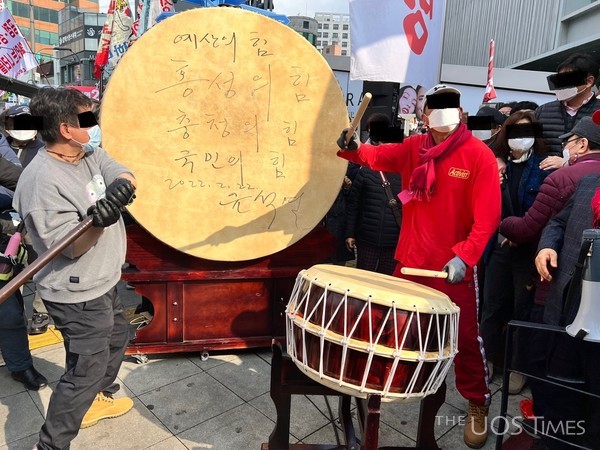On March 9, 2022, the 20th Presidential Election was held in South Korea, and the People Power Party(PPP)’s candidate Yoon Suk-yeol became the victor. The election, similar to previous elections, managed to heat up the whole country, not only with quarrels and controversies, but also with songs and dance routines. What do singing and dancing have to do with elections? Generally, in many countries, candidates canvass for votes by running on-site campaigns, participating in debates, putting up posters, running advertisements on televisions. However, candidates in South Korea have also adopted several other unique, energetic, and friendly campaign methods. During the election campaign, from February 15 to March 8 this year, trucks remodeled for electioneering and decorated with photos of candidates, as well as representative colors of political parties, could be easily found on the streets, roads, and everywhere else. Those trucks played jingle songs and were used as a stage for speeches and dance moves. The UOS Times tried to capture a glimpse of the 20th presidential election campaigns.

Campaign Vehicles
Campaign vehicles are generally made by renovating trucks. One side and the rearward wall of the truck’s luggage compartment are removed so that the inner space of the luggage compartment can be seen outside. The candidate's poster is attached on its sides, and the whole truck is painted with the representative color of a certain political party. These vehicles carry campaigners and travel around the country, play jingle songs and videos, and when stopped, they are used as stages for speeches or dance moves.


Jingle Songs (Election Songs)
A jingle song (called “logo song” in Korea) is created by rewriting an existing popular song’s lyrics with the candidate's name, symbol number, promise, images, and slogans. It is a strategy for effectively imprinting the candidate in people’s minds by using addictive songs. To target multiple generations, famous songs for each period (e.g. the 1960s, 1990s, etc.) are chosen for jingle songs. In addition, the most popular songs during the election period and songs aimed at a specific region are also used. The trot is the most common genre for jingle songs because it has a simple melody, and it is easy to change the lyrics. Jingle songs have been used steadily until now, starting with the use of jingle songs by candidates Roh Tae-woo, Kim Young-sam, and Kim Dae-jung in the 13th presidential election. It is such an effective method that there is a saying: "One well-made jingle song makes one seat in the National Assembly."
Representative Jingle Songs of 20th Presidential Election Candidates
Candidate No.1 Lee Jae-myung of the Democratic Party of Korea (DPK)
“Amor Fati” – Kim Yon-ja (https://youtu.be/Rbfw6FIc0u0)
“Amor Fati” is an EDM-style trot song that tells you to love your life and to enjoy the present. Although this song is a trot, which is a genre that the elderly enjoy listening to, its exciting melody and comforting lyrics have been greatly loved by all generations in Korea, including young people. The DPK rewrote the lyrics to contain Lee Jae-myung’s pledges and slogans and changed the chorus from “Amor Fati” to “No. 1 Lee Jae-myung,” “economy president,” and so on.
Candidate No.2 Yoon Suk-yeol of the People Power Party (PPP)
“Jjiniya (You are a genuine person, in English)” – Young Tak (https://youtu.be/EIVyNtc2QOs)
“Jjiniya” is a semi-trot song about promising to love the only person you can trust in a world full of fakes. It has been loved for its unique addictive melody and lyrics with a strong impression. The PPP rewrote this song, assuring that the only person people can trust in these difficult times is Yoon Suk-yeol. Moreover, they put the phrase "No. 2 Yoon Suk-yeol" several times in the lyrics so that the candidate’s name could be engraved on people’s minds.
Candidate No.3 Sim Sang-jung of Justice Party
“Sinhodeung (Traffic Lights, in English)” – Lee Mu-jin (https://www.youtube.com/watch?v=clQYnEnfSnQ)
“Sinhodeung” is a jazz-style folk song that expresses the confusion felt by the young generation who have just become adults. Lee Mu-jin, the singer, wrote the lyrics by comparing the complicated society to the rules on the road and the world that people in their twenties see to a yellow light that a novice driver sees, respectively. Considering that blue and red are the representative colors for DPK and PPP each, and that yellow is the representative color of the Justice Party, it is interesting that the lyrics "three seconds between red and blue, that short time" was changed to "Sim Sang-jung of the Justice Party between red and blue" in the jingle song.
Candidate No.4 Ahn Cheol-soo of The People’s Party (resigned)
“Jilpunggado (Highway in the Gale, in English)” – Yoo Jeong-seok (https://www.youtube.com/watch?v=jsSWhPshb74)
“Jilpunggado” is a theme song of the animation “Ultimate Muscle II,” and it is about having the courage and the hope to not give in to difficulties. It is often used as a cheering song thanks to the hopeful, challenging, and passionate lyrics. Instead of changing the lyrics of the song, Ahn Cheol-soo chose to put slogans between the lyrics. He put the phrase "Candidate No. 4 Ahn Cheol-soo" the most and emphasized that he would create a right, clean nation that is strong in science and economy.
*This song was the most chosen song in this election, which was used by the four candidates (No. 1, 3, 4, 11).
Dance Moves and Performances
Election campaigners all wear uniforms and masks with colors representing their own party and perform the dance routines along with the jingle songs. Not only party members but also citizens can participate in the moves as part-time jobs. People can often see them dancing while walking on the streets; however, during large-scale campaigns where the candidates join, they do more diverse performances. For example, candidates do the dance routine together, and campaigners use a variety of tools, such as drums, janggu (double-headed Korean drum with a narrow waist in the middle, in English), balloons, cheering stick balloons, and flags.



South Korea's election campaign is conducted in a cheerful way that breaks away from the hard and serious image of elections and uses music and dance to get closer to voters. This repeatedly imprints the candidate in the public eye and makes people feel that the candidate is friendly, which in turn induces voters to cast their votes for the candidate. The UOS Times hopes that our readers could feel the excitement of Korean electioneering vividly through this article.

